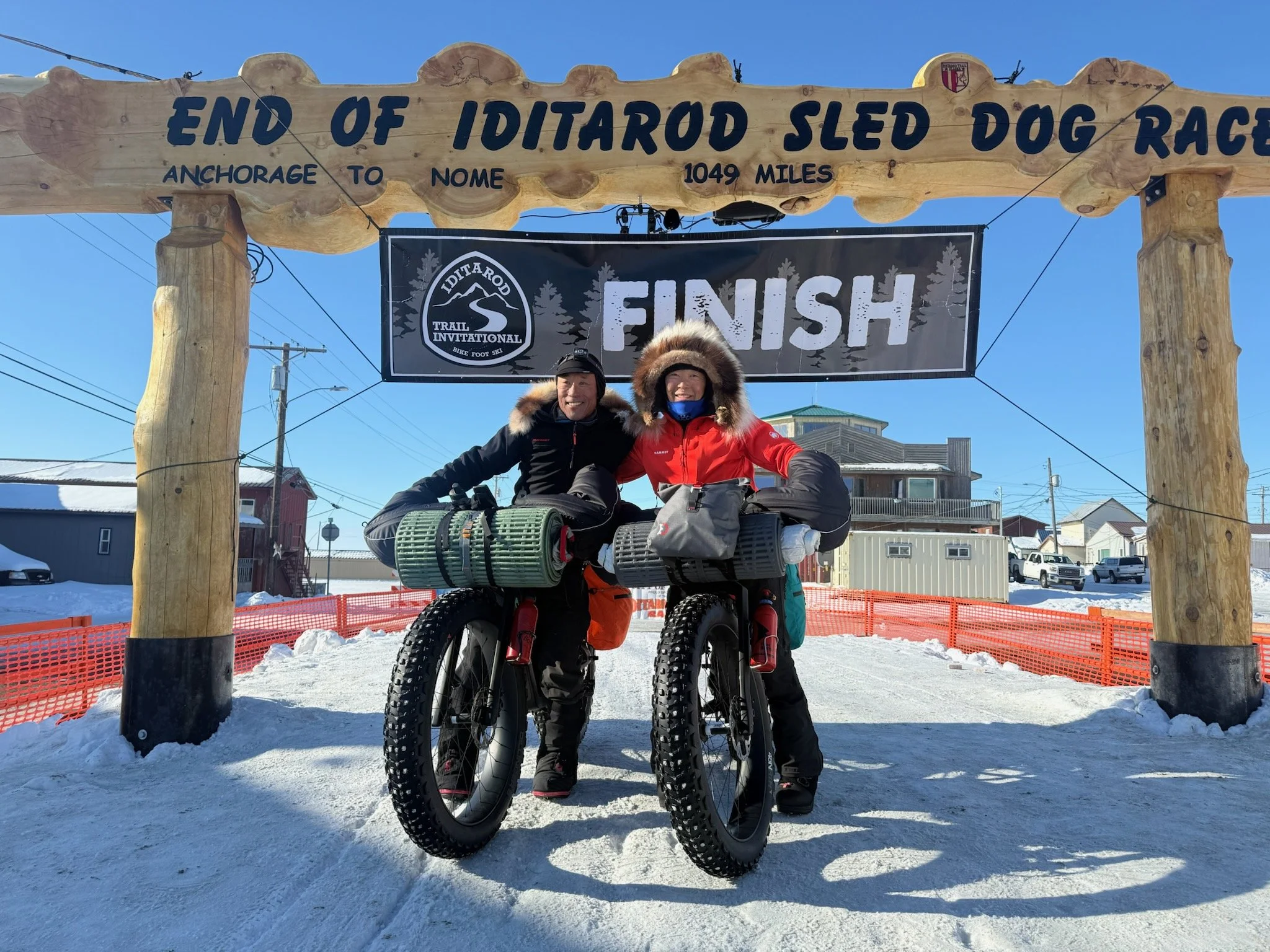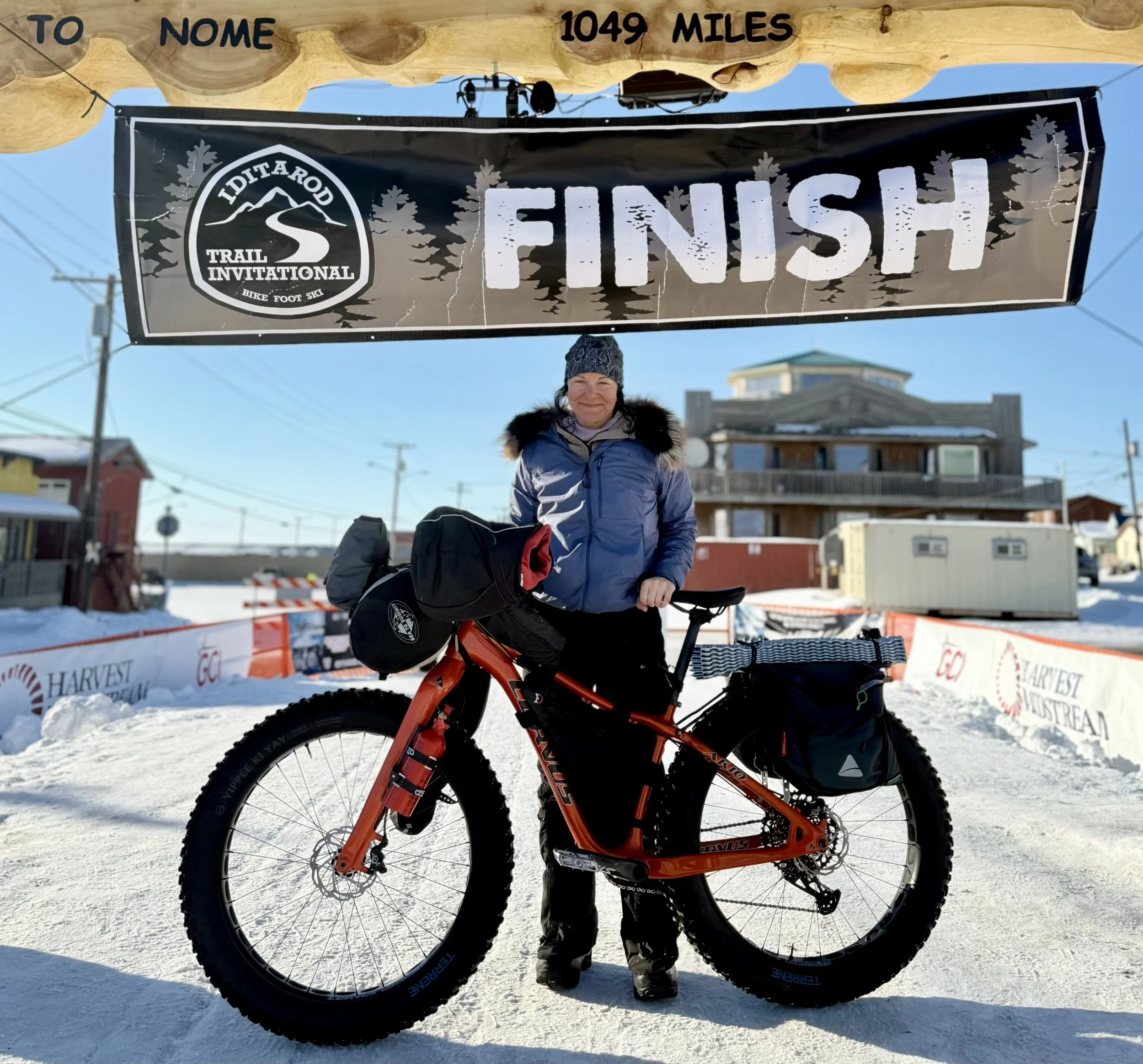This morning, twenty-one 1,000 milers remained on the journey to Nome, split into four main groups from Galena to Nome. The strong lead pack of men in the 1,000 bike division, ITI 2025’s “magnificent seven,” awoke with merely 54 miles to go to reach the burled arch in Nome. They have been traveling together the past 2-3 days and spent their last (likely cozy) night together in a new cabin that is not marked on Trackleaders, in the Topkok hills. This group has been seeing firm, fast conditions in the morning and softer (sometimes pushing) conditions in the afternoons as the now mid-March sun softens the snow, regardless of wind or air temps. They left the Topkok hills cabin around sunrise this morning and have been moving together in a tight group through the Topkok hills, past Safety Sound, moving efficiently through the blowhole remaining unscathed, and eventually riding fast (clocking speeds over 12 mph) on the Nome road to finally reach the brand new burled arch, built by musher Ramey Smith, whose wife Becca Moore is an ITI 350 bike veteran. The magnificent seven finished well ahead of the lead musher (last reported in Golovnin), with a strong finish time of 17 days, 2 hours, and 38 minutes.
To the seven of you, our sincerest congratulations. You are all true champions! Enjoy your victory lap on the long road into Nome and bottle up these feelings of accomplishment to remember later. You have much to be proud of, and we can’t wait to hear the rest of the stories from the trail. But first, for the faithful dot watchers, let’s uncover a bit about who our champions are on and off the trail.
Roberto “Robi” Gazzioli: Robi a friend and a colleague who works with the Mulonia brothers (more on them next), guiding bike trips. He gave a tongue-in-cheek sponsorship shoutout to his friend, as he is actually riding one of Willy’s bikes on this journey. Robi has completed the 350 on foot three times, and has ridden twice all the way to Nome in 2022 & 2023, with a third ride that ended in Unalakleet prior. ITI was Robi’s very first winter ultra in 2008, he purchased a down sleeping bag and jacket in Alaska that year before starting the race and he is still using them on this race 17 years later. There were no qualifying events at that time, and Robi believes the fact that he hailed from Brescia– a community in northern Italy with a good tradition of ITI participants– might have helped his initial odds of acceptance into the event. Robi bike commutes 20k to and from work every day as his training, and uses this as a mental boost when he is within the last 20k of a goal or checkpoint, “It’s just a ride home.”
Tiziano Mulonia: Tiziano Mulonia hails from Chiari, Italy, just west of Brescia. He is known as the group navigator and weatherman, always informing the group how much further to the next checkpoint or safety cabin and what the weather will be tomorrow. He was a late bloomer when it came to cycling, with his older brother Willy’s influence finally rubbing off on him. But once he started cycling, the ITI became his obsession. This is his sixth consecutive ITI, racing the 350-miler in 2020 and 2021, and the 1,000-miler every year since 2022. Every winter he comes to the U.S. from Italy a month or more in advance of the ITI to train and acclimate to the cold conditions.
Willy Mulonia, aka “Zio WIlly” or Uncle Willy: This year will mark Willy’s 8th ITI finish and his 4th attempt to Nome. His first run was in 1999. In 2000, WIlly experienced a serious and life threatening accident in the Alaska Range, but it didn’t stop him from going after his dream of the 1,000. A great recent USBC substack article by Hard Yaka includes this great quote from Willy summing up what he learned from the experience: “Over all these years, I came to understand that Alaska is not a dangerous place. I’m what’s dangerous in Alaska—if I don’t know what I’m doing. Because if you know the circumstances, if you know how to move with the people, if you know what your expectation is for help—and my expectation is zero—then everything you receive is like a gift. The most dangerous thing in Alaska is me.” Read the Full article here. When Willy is not racing the ITI, he works as the Founder & President of PA Cycling (https://pa-cycling.cc/), running adventure cycling trips around the world from his home base in Spain.
As one of the most experienced riders in ITI this year, one wonders what might bring a person back year after year. Willy shared that what motivates him is knowing “life is like a book of blank pages on which we write our story, well… then I am the pencil I use to write, and the ITI is a sharpener. With time and writing, all pencils get dull, making it harder to write clearly. The ITI helps me stay sharp and always become a little better.” He shared in his pre-race survey that the three things he could not live without on the trail are the snow, Robi, and his brother Tiziano. With that said, we are glad he made it through the snow-less tussocks, and hopefully was able to enjoy some of his favorite trail snack to help him through the snow-less lows: Parmigiano Reggiano with embark, “like a cheesecake.”
Leah Gruhn shared many miles in the 2023 ITI 1,000-mile race with Robi, Tiziano, and WIlly in 2023 and describes them as “industrious, hard working, welcoming, fun-loving, and top-notch travel companions.”
Peter Delemere: Peter is an expert in space physics at the University of Alaska Fairbanks Geophysical Institute. While his companions on the trail may have enjoyed the magic and beauty of the aurora this year, Peter most likely saw them as particles, energy, magnetic fields, and material blasted into the solar system by a solar storm. Science writer with the Geophysical Institute at the University of Alaska Fairbanks, Ned Rozell, wrote a great piece on him in 2024, describing how in his 2024 ride to McGrath, all Peter Delamere could think about was the dichotomy paradox, a concept Aristotle included in his work “Physics.” Forward motion is an illusion because halving the distance to your goal is a never-ending process. “I crawled across the landscape, inching closer and closer to McGrath, but with the finish seemingly out of reach,” Delamere wrote in a summary of his race experience. Today he will continue to bear the heavy mental burden of the “dichotomy paradox” until he is safely under the arch at a remaining distance value of “zero.”
Casey Fagerquist: Casey calls Anchorage home though he grew up in Casper, Wyoming. He moved to Alaska to attend college (he was a collegiate Nordic Ski racer) and like so many others he never left. Casey had aspirations of going to the Olympics, but got “distracted” by all of the incredible outdoor adventures Alaska had to offer. Nordic-ski racing definitely acquaints a person with the depths of the pain cave early in life, so Casey is well-equipped for the suffering of winter ultra endurance events. He doesn’t subscribe to a lot of gym time or ‘that wattage stuff,’ his MO is to get out and ride outside no matter how bad the weather, and this certainly serves him in the Alaskan backcountry. Casey has completed both the 350 and the ride to Nome multiple times before, (including one race while he had the flu), and he went to Nome in 2020, a year when only three finishers made it. He also had the wild experience of exiting the wilderness bubble only to find North America completely shut-down due to the COVID-19 pandemic.
Joshua Brown: Is he about to earn the first ever ITI 1,000 Triple Crown?! Nome isn't new territory for Josh. He previously completed the foot division race in 2022, and upon finishing in 2024, became just the third person ever to complete the 1000-mile ski division in ITI history. He's the first competitor to finish both the 1000-mile foot and ski divisions—despite having minimal cross-country skiing experience until a few years ago, and will become first racer in history to complete a triple threat (completing the race via bike, foot, and ski in different years). Josh had us chuckling along the way this year as he commented to volunteers in Nikolai he did not intend to be toward the front as he is “not much of a biker.” This is clearly a pattern, because as a skiing novice just a few years ago, he said much of the same before becoming one of the first skiers ever to finish the 1,000-mile race. To prepare for his 2024 ski attempt, Josh researched nordic skiing and devoted himself to training, skiing several hours before work and practicing with Alaska Pacific University's highly ranked nordic ski team during the evenings. When not on skis, he tested various equipment and even crafted custom gear from basic materials. As previously suggested, finishing the ITI 1,000 once transcends physical and mental achievement. Finishing it three times in three different modalities is beyond next-level.
Josh, known for his unwavering persistence and strong work ethic, serves as an active-duty Lieutenant Colonel at Joint Base Elmendorf-Richardson, and works as a medical advisor for the Air Force's Arctic Warrior program. He is uniquely qualified for the race to Nome, as it turns out, as his vocational role involves developing innovative approaches and equipment, and enabling military operations in extreme cold conditions, and the ability to adapt and endure through difficult circumstances represents one of his greatest strengths. He resides in Eagle River with his spouse and three children, where they frequently spend free time exploring Alaska's natural environments.
Josh's ITI involvement extends beyond just competing. In 2023, rather than racing in the ITI, he prioritized giving back to the community by managing the Nikolai checkpoint for nine days alongside Jon Richner (the current lead foot racer en route to Nome this year). The two of them share more than 20 years of friendship.
Cptn Mike Beiergrohslein: Mike is an ITI veteran who has been to Nome once before in 2016 (and swiftly, in 17D:7hr:47 min– shoutout to Mike’s mom for the quick stat!) and Mike has also ridden to McGrath a number of times. He is married to Alycia, and they have three children who all love biking, skiing, and other outdoor adventures. According to Alycia, Mike is not overly concerned about “his finish time” on the trail, as he enjoys time in checkpoints, meeting people, and good conversations, and good rest. Fellow racer Jill Homer shared some miles with Mike on her ride to Nome in 2016, and describes him as “good-humored and positive” as a traveling companion. She recalled one story where they encountered the Happy River, wide open and flowing fast above Puntilla Lake. Mike came upon another racer, Robert Ostrom, who had nothing waterproof to pull over his boots. So Mike put on his waders and carried his own bike across, then ferried Robert’s bike across, then returned a third time to collect Robert (a normal sized man), who rode across on his shoulders. Jill remarked that the current was strong enough to push them downstream with any slip, but for Mike it was all in good fun. His wife, Alycia said “This is the way he likes to take a vacation, challenging himself and enjoying Alaska.” Mike is in the public health service commission corp, and practices pharmacy in the Anchorage area. An avid hunter and outdoorsman, Mike reported in a recent Bikepacker article that one prized item in his 2025 kit is his humanely harvested Alaska-raised moose & salmon jerky for the trail. We hope Mike enjoyed this year’s “vacation” very much.
Again, our warmest congratulations to you all, it has been a true pleasure watching your dots.
Getting accurate weather details for our racers has been both an art and a science. Weather in Nome may vary from the weather at Safety Sound, just as weather in Shaktoolik can be quite different from the weather further out on the sea ice. Even the weather in White Mountain tends to be calmer than the weather just downtrail in the Topkok hills. As far as we know, this morning’s temps ranged from 0F in Koyuk to 5F in Nome for our lead bikers. According to the Johnson’s camp weather station near the Solomon blowhole, winds were gusting over 30 mph last night, but dropped throughout the day today to the teens. While the blowhole appeared to cooperate for our lead riders, we know it is not to be trifled with, and that others may contend with different conditions in the days to come. One cautionary bit of ITI lore is that in the 2018 race, three bikers (Jay Cable, Phil Hofsetter, and Kevin Breitenbach) moving through the blowhole came upon two hypothermic mushers (Janssen and Lanier) huddled together. They had been pinned by 50 mph subzero wind gusts and were certain they would have died, if not for the bikers who were able to activate an SOS signal to call for rescue.
Behind the lead pack, our second group of bikers, Perry Jewett, Matt Garretson, and Troy Szczurkowski are making their way across Golovnin Bay this afternoon during a fair weather window. They will likely stay in White Mountain or the Topkok hills cabin this evening.
Behind them, the third group of five bikers, made up of Janice Tower and Matt Tanaka (Team tanaka) and also Julie Perilla Garcia and her friend Karl Booth, plus Ryan Wanless, appear to be enjoying a well earned layover day in Koyuk. Yesterday was likely only slightly better than a stick in the eye, as this group of five crawled across Norton Sound for an 11 hour slog into a strong headwind and blowing snow. They pushed their bikes for most of it, riding only a bit of it until finally reaching Koyuk around 10 PM. They have all been taking a well earned rest today, still tucked into their sleeping bags past noon.
Lead foot athlete Jon Richner and lone skier Erick Basset are in the Kaltag area. Behind them, the lead women’s foot athlete Kari Gibbons is in Nulato, with Petr Ineman just a few miles out. Kari was looking especially strong today. She left Nulato yesterday afternoon and moved for about 11 hours before bivying at the large bow in the Yukon for 6-7 hours, and then she set out again early this morning for Nulato finally turning south with her wind at her back which had to have been a reprieve. She appears to be moving well with her new cookies from Galena and her ramen breaks. Magdalena Paschke continues at the same cadence, just 8-10 hours behind Kari. We received a fun photo of Magdalena from Christof Teuscher last night and she appears to be all smiles on the Yukon
The moon is full tonight and will be visible now in the clear skies over Nome, a glowing reminder that we are just a little over 2 full weeks into this event which began with a new moon and will not end until the moon is nearly new again. 14 intrepid 1,000 milers remain on the trail tonight, and we will continue to bring you updates until the last one has completed their journey to Nome.
Author: Allison Carolan

















